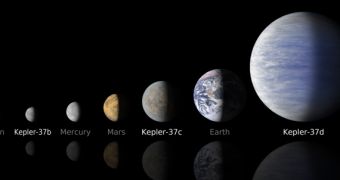This past February 20, NASA went public with the news that the scientists now taking part in its Kepler mission had succeeded in identifying a new planetary system.
What makes this planetary system stand out amongst others of its kind in the fact that, by the looks of it, it is home to the smallest planet known to the scientific community thus far.
More precisely, the NASA researchers who found it maintain that, all things considered, this tiny planet is about one third the size of the Earth, and even smaller than Mercury. Furthermore, it is only slightly larger than our moon.
As was to be expected, its being so small was precisely what made it quite difficult for the NASA scientists working on this project to pin it down.
The official website for NASA explains that this moon-sized planet is accompanied by two other ones, and that all three of them are part and parcel of a system known as Kepler-37.
This system is located in the constellation Lyra, at a distance of roughly 210 light-years from the Earth.
Because of their being found in this system, the planets have been given the following names: Kepler-37b will from now on be used to refer to this stunningly small planet, and Kepler-37c will be used to refer to its closer neighboring planet, which is just a tad smaller than Venus.
On the other hand, Kepler-37d has officially become the name of Kepler-37b's farther neighboring planet, whose size is roughly two times that of the Earth.
By the looks of it, Kepler-37b cannot support life as we know it, simply because it lacks an atmosphere. As well as this, NASA maintains that the planet is likely to have a rocky composition.
Furthermore, the scientists who found Kepler-37b explain that this particular planet orbits its star in 13 days.
“We uncovered a planet smaller than any in our solar system orbiting one of the few stars that is both bright and quiet, where signal detection was possible,” stated Thomas Barclay, Kepler scientist at the Bay Area Environmental Research Institute in Sonoma, California.
“This discovery shows close-in planets can be smaller, as well as much larger, than planets orbiting our sun,” Thomas Barclay went on to add.
A detailed study concerning the discovery of this small planet was published in the scientific journal Nature only yesterday.

 14 DAY TRIAL //
14 DAY TRIAL //